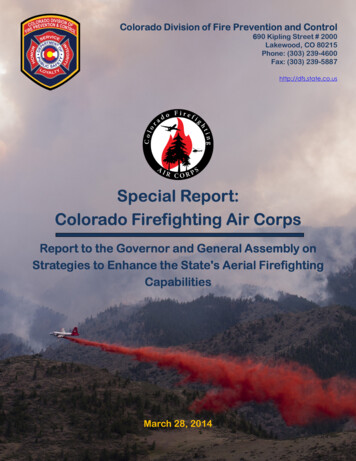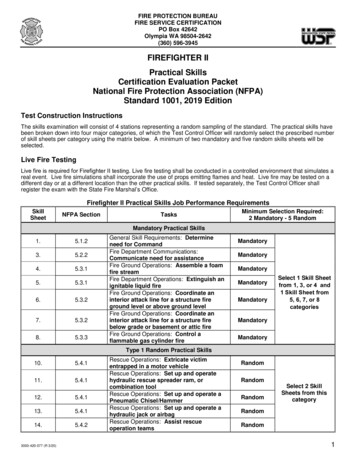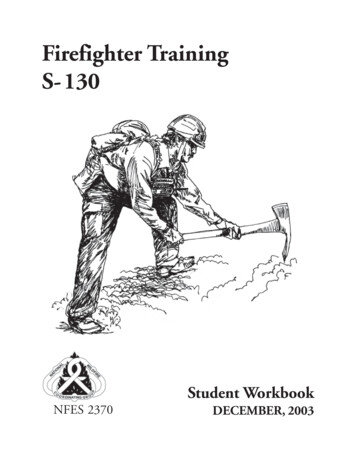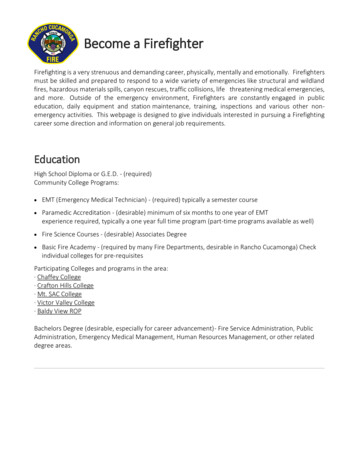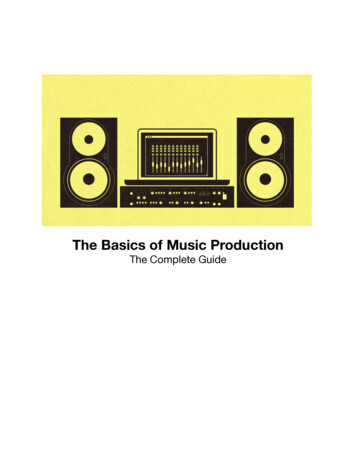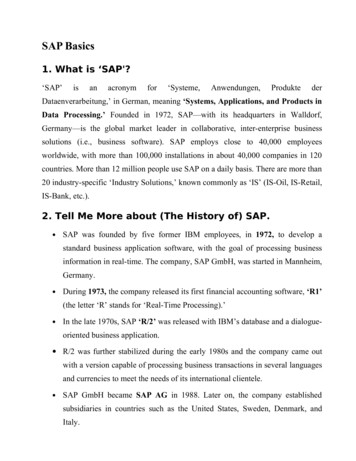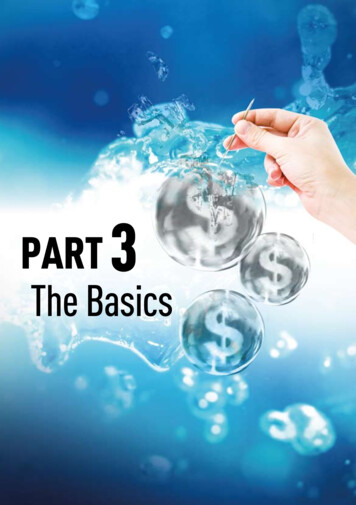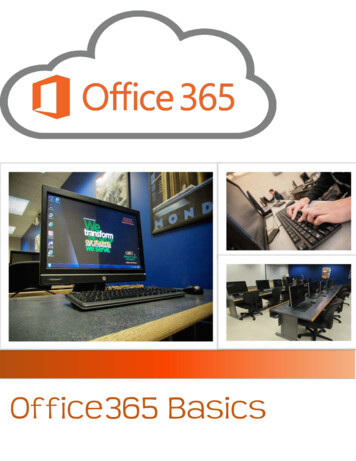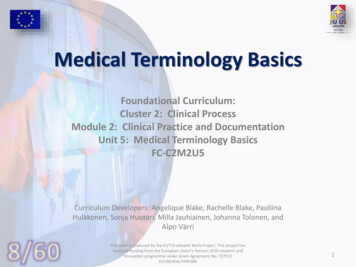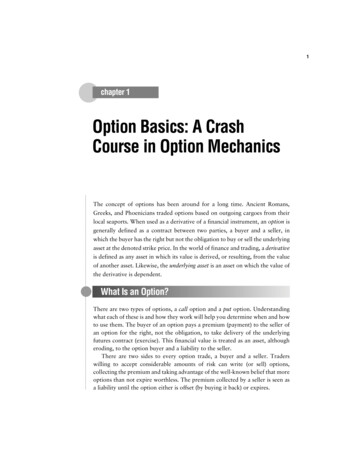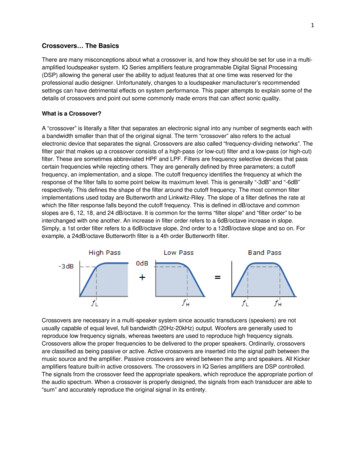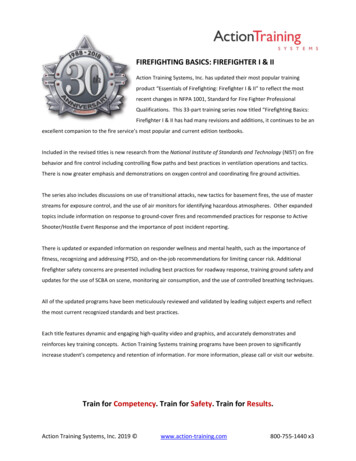
Transcription
FIREFIGHTING BASICS: FIREFIGHTER I & IIAction Training Systems, Inc. has updated their most popular trainingproduct “Essentials of Firefighting: Firefighter I & II” to reflect the mostrecent changes in NFPA 1001, Standard for Fire Fighter ProfessionalQualifications. This 33-part training series now titled “Firefighting Basics:Firefighter I & II has had many revisions and additions, it continues to be anexcellent companion to the fire service’s most popular and current edition textbooks.Included in the revised titles is new research from the National Institute of Standards and Technology (NIST) on firebehavior and fire control including controlling flow paths and best practices in ventilation operations and tactics.There is now greater emphasis and demonstrations on oxygen control and coordinating fire ground activities.The series also includes discussions on use of transitional attacks, new tactics for basement fires, the use of masterstreams for exposure control, and the use of air monitors for identifying hazardous atmospheres. Other expandedtopics include information on response to ground-cover fires and recommended practices for response to ActiveShooter/Hostile Event Response and the importance of post incident reporting.There is updated or expanded information on responder wellness and mental health, such as the importance offitness, recognizing and addressing PTSD, and on-the-job recommendations for limiting cancer risk. Additionalfirefighter safety concerns are presented including best practices for roadway response, training ground safety andupdates for the use of SCBA on scene, monitoring air consumption, and the use of controlled breathing techniques.All of the updated programs have been meticulously reviewed and validated by leading subject experts and reflectthe most current recognized standards and best practices.Each title features dynamic and engaging high-quality video and graphics, and accurately demonstrates andreinforces key training concepts. Action Training Systems training programs have been proven to significantlyincrease student’s competency and retention of information. For more information, please call or visit our website.Train for Competency. Train for Safety. Train for Results.Action Training Systems, Inc. 2019 www.action-training.com800-755-1440 x3
Firefighting Basics: Firefighter I & IIDelivery Formats (includes closedcaptioning): Online Interactive CoursesOnline Streaming VideosDVDsAdditional Materials: ATS PowerPoints, ATS QuestionFiles, ATS Facilitator Guides, and Textbooks/Curriculumfrom Publishing Partners’ (IFSTA & PSG/J&B)When it comes to training firefighters for certification or recurrent training purposes, our updated 33part video-based training series, Firefighting Basics: Firefighter I & II, includes everything you havecome to trust and depend on from Action Training Systems.All titles feature: Dynamic and engaging high-quality video that has been meticulously reviewed and validated byleading subject matter experts Instructionally designed and simplified technical material that reinforces training objectives Skills demonstrations and prerequisite knowledge that covers key training conceptsThis series teaches to current NFPA 1001: Standard for Fire Fighter Professional Qualifications, and isan excellent teaching companion to popular textbooks and training manuals. Our videos are proven tosignificantly increase learner comprehension and the retention of information, making for a morecompetent responder.FIREFIGHTER I1. Firefighter Safety: Part 1 Video Runtime – 27:01Presents an overview of fire department and firefighter responsibilities under NFPA 1500, including howimportant health, fitness and mental wellness is to your safety, ways to limit your exposure to cancercausing risks and other work place hazards, including tips for accident and injury prevention. Alsoreviewed is the use of the ICS system and how control zones help you to avoid or identify risks at anemergency scene or active shooter event.Training Objectives:1. Firefighter Responsibilities of NFPA 15002. Firefighter Fitness, Health & Wellness3. Fire Station Safety & Training Safety 2019 Action Training Systems, Inc.4. The Incident Command System5. Hazard Control Zoneswww.action-training.com1-800-755-1440 ext. 31
2. Firefighter Safety: Part 2 Video Runtime – 24:11Discusses standard operating procedures and the importance of teamwork. Describes accountabilitysystems and on-scene rehabilitation and their importance to safety. Presents survival methods forfirefighters who become disoriented or trapped in fires. Identifies safe procedures for riding fireapparatus, working on roadway emergency scenes, shutting off utilities at an emergency scene andresponding to electrical emergencies.Training Objectives:1.2.3.Safety in Standard Operating Procedures &TeamworkPersonnel Accountability Systems & On-SceneRehabilitationDisorientation or Entrapment Survival3. Fire Dynamics4.5.6.7.Vehicle Passenger SafetyRoadway SafetyUtility Shut Off ProceduresSafety at Electrical EmergenciesVideo Runtime – 27:02Describes the science of fire and combustion, the fire tetrahedron, states of fuel, pyrolysis andvaporization. You will also learn to identify types of heat energy, methods of heat transfer, the stages ofcompartment fire development, the products of combustion, structure fire flow paths and factors inrapid fire development.Training Objectives:1.2.3.4.5.Fire & CombustionOxygen & Oxidizing AgentsFuel: Pyrolysis & VaporizationHeat Energy & Self-Sustained Chemical ReactionThree Methods of Heat Transfer4. SCBA 1: Introduction6.7.8.Products of Combustion & Fire DevelopmentFactorsStages of Compartment Fire DevelopmentStructure Fire Flow PathsVideo Runtime – 27:55Presents the functions of each component of the SCBA system, safety features of various types of SCBA,limitations of SCBA and a review of hazardous environments that require respiratory protection.Training Objectives:1. Open-circuit SCBA & Components2. The Harness & Air-Cylinder Assemblies3. The Regulator Assembly4. The Facepiece Assembly5. SCBA 2: Use & Maintenance5. SCBA Safety Features & Precautions6. Hazardous Atmospheres7. SCBA LimitationsVideo Runtime – 27:01Demonstrates correct SCBA donning and doffing techniques, inspection and care procedures, how tochange and fill cylinders, and safety precautions and rules for using SCBA in emergency situations.Training Objectives:1. Donning Using the Over-the-Head Method2. Donning Using the Coat Method3. Donning a Mounted SCBA4. Donning the Facepiece 2019 Action Training Systems, Inc.5. Doffing Techniques6. Inspection & Care Procedures7. Changing & Filling Cylinders8. SCBA Safety & Emergency Procedureswww.action-training.com1-800-755-1440 ext. 32
6. Personal Protective ClothingVideo Runtime – 27:36Lists the elements of the complete protective ensemble worn by firefighters and describes thefunctions and specifications for each element of personal protective clothing. Describes specialclothing situations, firefighter responsibilities for the care and maintenance of turnout gear andsafety requirements for work uniforms and safety shoes.Training Objectives:1. The Protective Ensemble2. Hoods, Helmets & Eye Protection3. Protective Coats & Pants4. Gloves & Boots7. Portable Extinguishers5. Special Clothing Situations6. Turnout Gear Care & Maintenance7. Work Uniforms & Safety ShoesVideo Runtime – 27:14Designed to be used in public education programs as well as fire service training. Presents theclassification and rating system used for extinguishers, types of hand-held extinguishers and how toselect the correct extinguisher for a fire. Presents steps for operating portable extinguishers anddemonstrates how to extinguish fires using the most common types of extinguishers. Discussesextinguisher maintenance and demonstrates extinguisher inspection.Training Objectives:1. Fire Extinguisher Classification & RatingSystem2. Types of Portable Extinguishers3. Basic Steps for Operating Fire Extinguishers4. Stored-Pressure Water & Foam Extinguishers8. Ropes & Knots5. Carbon Dioxide Extinguishers6. Dry Chemical Extinguishers7. Dry Powder Extinguishers8. Extinguisher Inspection & MaintenanceVideo Runtime – 27:18Presents types, ratings and uses for fire service rope. Describes rope materials and construction,methods for inspecting rope and how to maintain and store rope. Demonstrates commonly used fireservice knots and methods for hoisting equipment.Training Objectives:1.2.3.Fire Service Rope Uses, Ratings & TypesRope Materials & ConstructionInspecting Ropes9. Fire Control 14.5.6.Rope Maintenance & StorageKnot-Tying Terminology & Tying Knots & HitchesHoisting methods with RopesVideo Runtime – 23:50Discusses basic fire control strategies and safety. Demonstrates how to advance a chargedattack line into a structure fire, methods of water application, master stream devices, basic firesuppression tactics for Class B fires, and techniques for suppressing vehicle fires, exterior class A,and ground-cover fires.Training Objectives:1. Fire Control Strategies & Safety2. Advancing an Attack Line3. Methods of Water Application4. Master Stream Devices 2019 Action Training Systems, Inc.5. Class B Fires6. Vehicle Fires7. Exterior Class A & Ground-Cover Fireswww.action-training.com1-800-755-1440 ext. 33
10. Ladders 1Video Runtime – 21:42Defines basic ground and aerial ladder terminology. Discusses ladder types, construction and uses onthe fireground. Demonstrates ladder maintenance and inspections, and the basics in ladder handling.Training Objectives:1. Ground Ladder Terminology2. Aerial Ladder Terminology3. Ground Ladder Materials, Types & Uses11. Ladders 24. Maintenance: Cleaning & Inspecting Ladders5. Ladder Selection & Safety6. Ladder Carries for 1, 2, & 3 FirefightersVideo Runtime – 18:56Shows factors that affect ground-ladder placement, correct ladder placement to meet specific objectivesand ladder raises for one, two and three firefighters. Demonstrates procedures for securing ladders,methods for climbing ladders and how to place a roof ladder.Training Objectives:1. Ladder Placement Factors2. Raising & Positioning Ladders3. 1- Firefighter Ladder Raises4. 2 & 3 Firefighter Ladder Raises5. Securing Ladders6. Climbing & Working From Ladders12. Ventilation Basics & Horizontal ProceduresVideo Runtime – 23:06Describes the fundamentals of ventilation, including benefits and safety concerns, with a focus onhorizontal ventilation techniques. Describes hazards of rapid fire development and the importance ofcoordinating ventilation activities with suppression operations. Also discussed is the use positivepressure, negative-pressure and hydraulic ventilation.Training Objectives:1.2.3.Ventilation & Oxygen ControlHazards of Rapid Fire DevelopmentNatural Horizontal Ventilation Operations4.5.Mechanical Ventilation: Positive & NegativeMechanical Ventilation: Hydraulic13. Vertical VentilationVideo Runtime – 27:37Describes safety precautions for rooftop operations, roof types and construction and their impact in verticalventilation. Shows how to determine the integrity of a roof system and basic indicators of roof collapse.Demonstrates methods for opening flat and pitched roofs using a variety of techniques.Training Objectives:1.2.3.Vertical Ventilation Principles & Rooftop SafetyTypes of Common Roof ConstructionHow To Determine Roof Integrity4.5.Opening Flat & Pitched Roofs: The Square orRectangular CutThe Kerf, Triangular, Louvered & Trench Cuts14. Fire Hose Basics Video Runtime – 19:04Shows fire hose construction, sizes, uses, basic hose maintenance and how to prevent hose damage.Identifies types of hose couplings, tools and appliances and demonstrates hose-roll methods.Training Objectives:1. Basic Information About Fire Hose2. Fire Hose Maintenance3. Common Hose Couplings 2019 Action Training Systems, Inc.4. Common Hose Appliances5. Common Hose Tools6. Two Hose-Roll Methodswww.action-training.com1-800-755-1440 ext. 34
15. Handling HoseVideo Runtime – 22:19Presents guidelines for loading hose and basic types of hose loads and finishes. Demonstrates commonhoselays and methods for coupling and uncoupling hose.Training Objectives:1. Basic Guidelines for Loading Hose2. The Accordion Hose Load3. The Horseshoe Load & The Flat Load4. Hose Finishes16. Advancing Hoselines5. The Preconnected Flat Load & MinutemanLoad6. Two Common Hose Lays7. Methods of Coupling & Uncoupling HoseVideo Runtime – 21:57Demonstrates how to pull and carry hose from a pumper to the fire location for a variety of hoseloads.Shows how to advance hose into structures and in stairways, from a standpipe and up a ladder and howto hoist hose. Describes how to extend a section of hose and how to retrieve a loose hoseline. Showsbasic procedures for operating and controlling attack lines.Training Objectives:1. Pulling & Carrying Preconnected Hose2. Advancing the Flat Load & the HorseshoeLoad3. Advancing Wyed Lines & Working LineDrag4. Advancing into Structure & Stairways17. Fire Streams5. Advancing Hose From a Standpipe6. Advancing Hose Up a Ladder & HoistingHose7. How to Extend & Retrieve Hose8. Operating & Controlling Attack LinesVideo Runtime – 19:43Identifies basic sizes and types of fire streams and the advantages and disadvantages of each type.Shows the use and maintenance of different types of nozzles. Defines “water hammer” and shows howto prevent it.Training Objectives:1. Fire Stream Sizes & Types2. Solid Streams3. Fog (Spray) Streams18. Forcible Entry4. Nozzle Types & Maintenance5. Preventing Water HammerVideo Runtime – 19:56Identifies forcible entry tools and how they should be used and maintained. Demonstrates proceduresfor through-the-lock entry on doors and forced entry through different types of doors and windows.Training Objectives:1. Tool Basics: Cutting Tools2. Prying, Pushing/Pulling & Striking Tools3. Through-the-Lock Entry on Doors4. Forcing Entry Through Doors5. Forcing Windows19. Fire Detection, Alarms & CommunicationsVideo Runtime – 26:17Presents methods and technologies for receiving alarms from the public. Shows the basic components offire alarm and smoke detection systems. Presents an overview of the communications center andsystems for dispatching fire department personnel to an emergency. Demonstrates good radioprocedures and procedures for routine and emergency communications. 2019 Action Training Systems, Inc.www.action-training.com1-800-755-1440 ext. 35
Training Objectives:1. Receiving & Reporting Alarms2. Fire Detection & Alarm-Initiating Devices3. The Communications Center20. Lighting & Power Sources4. Systems for Dispatching Firefighters5. Basic Radio Procedures6. Routine & Emergency Incident CommunicationsVideo Runtime – 18:29Describe types of lighting used in the fire service, auxiliary electrical equipment and power plants.Reviews safety considerations for using lighting and electrical equipment. Demonstrates how to set upelectrical equipment, illuminate the emergency scene and maintenance of lighting and portable powerplants.Training Objectives:1. Lighting & Lighting Equipment2. Power Plants3. Lighting & Electrical Equipment Safety4. Maintaining Portable Power Plants21. Property Conservation: SalvageVideo Runtime – 21:24Presents the benefits of good salvage operations to the public and the fire department. Demonstratesthe procedures for storing and deploying salvage covers, how to construct a water chute and a catchallusing salvage covers and how to cover openings in the roof, windows and doors to protect the propertyfrom secondary damage.Training Objectives:1. Benefits of Salvage Operations2. Common Salvage Equipment3. Salvage Covers/One-Firefighter Spreads22. Property Conservation: Overhaul4. Salvage Covers/Two-Firefighter Spreads5. Water Chutes & Catch-Alls6. Covering OpeningsVideo Runtime – 20:35Presents indicators of structural instability and procedures for finding hidden fires. Describes proceduresfor opening concealed spaces, extinguishing hidden fires, preserving evidence and restoring thepremises after a fire.Training Objectives:1. Indicators of Structural Instability2. Finding Hidden Fires3. Opening Concealed Spaces & ExtinguishingHidden Fires23. Sprinkler Systems4. Preserving Evidence5. Restoring the PremisesVideo Runtime – 27:01Describes the effectiveness of sprinkler systems in saving life and property. Describes how sprinklerswork and presents different types of sprinkler systems, components of sprinkler systems and thelocations and appearance of control and operating valves. Describes considerations for responding tofires in protected buildings.Training Objectives:1. How Sprinklers Work2. Components of Sprinkler Systems3. Sources of Water Supply4. Control & Operating Valves5. Sprinkler Types & Release Mechanisms 2019 Action Training Systems, Inc.6. Wet-Pipe & Dry-Pipe Sprinkler Systems7. Deluge, Pre-Action & Residential SprinklerSystems8. Responding to Fires in Protected Buildingswww.action-training.com1-800-755-1440 ext. 36
FIREFIGHTER II1.Building ConstructionVideo Runtime – TBDDescribes construction classifications used in most building codes and the role of fire resistance ratings.Describes the characteristics and fire behavior of five types of construction, defines buildingconstruction terms, the effects of fire and fire suppression activities on various building materials.Identifies the signs of dangerous building conditions, such as heavy fire loads and building collapse.Training Objectives:1. Construction Classifications2. The Five Types of Construction3. Building Construction Terms4. Fire Effects on Wood & Masonry2. Rescue Operations5. Fire Effects on Steel & Reinforced Concrete6. Fire Effects on Gypsum & Glass7. Dangerous Building ConditionsVideo Runtime – 27:52Demonstrates how to move injured victims using carries and drags. Presents various types of rescuetools and the dangers of vehicle restraint systems. Demonstrates methods to extricate an entrappedvictim from a vehicle.Training Objectives:1.2.Moving Injured VictimsRescue Tools3. Advanced Ventilation3.4.Dangers of Vehicle Components & SystemsVehicle Extrication ProceduresVideo Runtime – 19:01Presents the factors affecting ventilation decisions. Shows precautions against upsetting verticalventilation, methods for ventilating a basement or windowless building and special ventilationconsiderations of high-rise buildings.Training Objectives:1. Ventilation Decision Factors2. A Decision-Making Sequence3. Precautions for Vertical Ventilation4. Water Supply4. Basements & Windowless Buildings5. High-Rise BuildingsVideo Runtime – 24:21Explains the components of water supplies for fire department operations, the operation of differenttypes of hydrants and how to service test fire hose.Training Objectives:1. Components of a Water System2. Parts of a Distribution System3. Valves in Water Distribution Systems4. Measuring Pressure5. Fire Control 25. Operating Hydrants6. Static & Mobile Water Supply7. Service Testing Fire HoseVideo Runtime – 20:10Demonstrates fire control tactics for difficult fires, including a large, exterior Class B fire, fires in upperlevels of structures, fires below grade, fires in energized electrical equipment and fires involving aflammable gas cylinder.Training Objectives:1. Using Foam on a Large Class B Fire2. Fires in Upper Levels3. Fires Below Grade 2019 Action Training Systems, Inc.4.5.Strategies for Energized Electrical Fires (Class C)Fire in a Flammable Gas Cylinderwww.action-training.com1-800-755-1440 ext. 37
6. Foam Fire StreamsVideo Runtime – 22:16Describes the fundamentals of foam, including how foam is generated, how it extinguishes orsuppresses fires, types of foam proportioners, nozzles and other foam generating systems and varioustypes of foam. Demonstrates how to assemble a foam fire stream using an eductor. Featurestroubleshooting tips for foam operations.Training Objectives:1. How Foam Extinguishes or Prevents Fire2. Generating & Proportioning Foam3. Nozzles & Foam-Delivery Devices7. Fire Hose Appliances4. Foam Types & Concentrates5. Foam Fire Stream AssemblyVideo Runtime – 14:57Shows different types of fire hose appliances, including valves, valve devices, fittings and intakedevices. Identifies the correct type of appliances to be used in specific fire ground operations.Demonstrates how to clean and maintain hose appliances.Training Objectives:1. Fire Hose Appliance Basics2. Valves3. Valve Devices8. Fire Origin & Cause4. Fittings & Intake Devices5. Maintaining Hose AppliancesVideo Runtime – 20:58Presents the firefighter's role in fire cause determination from first alarm to final overhaul. Shows howto secure the fire scene pending an investigation and describes legal considerations of fire causedetermination. Demonstrates how to safeguard evidence at the scene.Training Objectives:1. Fire Cause Determination2. Observations En Route & Upon Arrival3. Salvage & Overhaul Considerations4. Securing the Scene5. Legal Considerations & Evidence Preservation9. Pre-Incident & Fire Safety SurveysVideo Runtime – TBDPresents the firefighter’s role in fire prevention and preparedness. Demonstrates steps for conducting preincident surveys. Identifies common hazards found in occupancies and shows how to inspect fireprotection systems for readiness.Training Objectives:1. Prevention & Preparedness2. Conducting Pre-Incident Surveys3. Common Fire Hazards4. Fire Protection Systems10. Fire Prevention & Public EducationVideo Runtime – 23:27Explains the importance of fire prevention and public education to the fire department and to the community.Demonstrates how to conduct a residential fire safety survey, describes common fire and life safety hazards in thehome, how to present fire safety information to small groups and how to conduct station tours.Training Objectives:1. Community Risk Reduction Programs2. Home Fire Safety Surveys3. Hazards in the Home 2019 Action Training Systems, Inc.4. Presenting Fire Safety Information5. Conducting Station Tourswww.action-training.com1-800-755-1440 ext. 38
NFPA 1001 MatrixFirefighting Basics: Firefighter I & IIFirefighter I Title101 Firefighter Safety: Part 1In this title on “FirefighterSafety Part 1,” you will learnfirefighter responsibilities ofNFPA 1500, how importanthealth, fitness and mentalwellness is to your safety, waysto limit your exposure to cancercausing risks and other workplace hazards, and tips foraccident and injury prevention.Also reviewed is the use of theICS system and how controlzones help you to avoid oridentify risks at an emergencyscene or active shooter event.Training Objectives & NFPA StandardSection 2: Firefighter Responsibilities of NFPA1500Describe components of NFPA 1500 (4.4.1)Describe firefighter responsibilities in NFPA 1500.(4.4.1)Section 3: Firefighter Fitness, Health & WellnessDescribe the importance of fitness, health and wellnessas it relates to firefighter safety and injury prevention.(4.4.1; 4.3.10)Describe ways to limit exposure to toxic chemicals onthe fireground. (4.3.3)List signs and symptoms of stress. (4.4.1)Section 4: Fire Station Safety & Training SafetyDescribe fire station safety best practices. (4.4.1;4.3.10)Describe the importance of using good safetyprocedures during training exercises. (4.4.1; 4.1.1)Section 5: The Incident Command SystemDescribe the use of the Incident Command System atemergency incidents. (4.4.1; 5.1.5; 5.1.2; 5.3.2)Section 6: Hazard Control ZonesIdentify types of hazard control zones used atemergency scenes. (4.4.1; 4.3.3)102 Firefighter Safety: Part 2In this title on “FirefighterSafety Part 2,” you willlearn the importance ofstandard operatingprocedures, teamwork,accountability systems andon-scene rehabilitation forfirefighter safety. You willSection 2: Standard Operating Procedures &TeamworkDescribe standard operating procedures and theimportance of teamwork. (4.1.1; 4.1.2)Section 3: Personnel Accountability Systems &On-Scene RehabilitationDescribe accountability systems used for firefightersafety, and the use of on-scene rehabilitation areas.(4.2.4; 4.3.5)Section 4: Disorientation or Entrapment SurvivalIdentify methods for survival for firefighters who1
also learn survival methodsfor trapped or disorientedfirefighters and safeprocedures for riding in fireapparatus, working atroadway emergencies andsafe practices for electricalhazards.become disoriented or trapped in a structure fire.(4.2.4; 4.3.5)Section 5: Vehicle Passenger SafetyIdentify safe procedures for passenger safety whileriding in a fire apparatus. (4.3.2; 4.3.3)Section 6: Roadway SafetyDescribe safe procedures for working at roadwayemergency scenes. (4.3.3)Section 7: Utility Shut Off ProceduresDescribe utility shut off procedures at anemergency scene. (4.3.3; 4.3.18)Section 8: Safety at Electrical EmergenciesDescribe safety policies and procedures for respondingto electrical emergencies. (4.3.3)Section 2: Fire & CombustionDescribe the science of fire and combustion. (4.3.10;4.3.11)Section 3: Oxygen & Oxidizing AgentsDescribe the component of oxygen and other oxidizingagents in the fire tetrahedron and their role in firedevelopment. (4.3.11)103 Fire DynamicsIn this title on "FireDynamics," you will learn thescience of fire and combustion,the fire tetrahedron, states offuel, pyrolysis and vaporization.You will also learn to identifytypes of heat energy, methodsof heat transfer, the stages ofcompartment fire development,the products of combustion,structure fire flow paths andfactors in rapid firedevelopment.Section 4: Fuel: Pyrolysis & VaporizationDescribe the fire tetrahedron component of fuel andthe three states of fuel. (4.3.10; 4.3.11)Define pyrolysis and vaporization. (4.3.11)Section 5: Heat Energy & Self-Sustained ChemicalReactionDescribe the three types of heat energy and the role ofa self-sustained chemical reaction in the firetetrahedron. (4.3.4)Section 6: Three Methods of Heat TransferDescribe the three methods of heat transfer:Conduction, convection and radiation. (4.3.11)Section 7: Products of Combustion & FireDevelopment FactorsDescribe the products of combustion and firedevelopment factors. (4.3.11; 4.3.12)Section 8: Stages of Compartment FireDevelopment2
Describe the stages of compartment fire development.(4.3.11)Section 9: Structure Fire Flow PathsDescribe structure fire flow paths. (4.3.11)Section 2: Open-circuit SCBA & ComponentsDescribe the most commonly used SCBA in the fireservice. (4.1.1)List the main components of positive-pressure SCBA.(4.3.1)Section 3: The Harness & Air-Cylinder AssembliesDescribe the features and functions of SCBAcomponents, including the harness assembly and aircylinder assembly. (4.3.1)104 SCBA 1: IntroductionIn this title, “SCBA 1:Introduction,” you will learnthe functions of each componentof the SCBA system, safetyfeatures and limitations ofSCBA. Also presented is areview of the hazardousenvironments that requirerespiratory protection.Section 4: The Regulator AssemblyDescribe the regulator assembly. (4.3.1)Section 5: The Facepiece AssemblyDescribe the facepiece assembly. (4.3.1)Section 6: SCBA Safety Features & PrecautionsIdentify safety precautions and features of SCBA.(4.3.1)Section 7: Hazardous Atmospheres: Part 1Identify fire-related hazardous atmospheres whichrequire SCBA protection. (4.3.1; 4.3.21)Section 8: Hazardous Atmospheres: Part 2Identify non-fire related hazardous atmospheres whichrequire SCBA protection. (4.3.1)Section 9: SCBA LimitationsDescribe SCBA limitations as they relate to the wearer,the equipment, and the air supply. (4.3.1)105 SCBA 2: Use &MaintenanceIn this title on “SCBA 2: Use &Maintenance,” you will learncorrect SCBA donning anddoffing techniques, inspectionand care procedures, how tochange cylinders at anSection 2: Donning Using the Over-the-HeadMethodDemonstrate donning SCBA using the over-the-headmethod. (4.3.1)Section 3: Donning Using the Coat MethodDemonstrate donning SCBA using the coat method.(4.3.1)Section 4: Donning a Mounted SCBADemonstrate techniques for donning SCBA from amounted position. (4.3.1)3
emergency scene and safetyprecautions and rules for usingSCBA in emergency situations.Section 5: Donning the FacepieceDemonstrate procedures for donning a facepiece with amask-mounted regulator. (4.3.1)Section 6: Doffing TechniquesDemonstrate doffing procedures for SCBA with a maskmounted regulator. (4.3.1)Section 7: Inspection & Care ProceduresList inspection and care procedures for SCBA. (4.5.1)Section 8: Changing & Filling CylindersDemonstrate how to change SCBA cylinders at anemergency scene with two people and by yourself.(4.3.1)Demonstrate how to fill cylinders. (4.3.1)Section 9: SCBA Safety & Emergency ProceduresList SCBA safety precautions and emergencyprocedures during use. (4.1.1; 4.3.10)Section 2: The Protective EnsembleList the elements of the complete protective ensembleworn by firefighters. (4.1.1; 4.3.2; 4.3.3)Section 3: Hoods, Helmets & Eye ProtectionDescribe functions and specifications for personalprotective clothing including hoods, helmets and eyeprotection. (4.1.1; 4.3.2)106 Personal ProtectiveClothingIn this title on “PersonalProtective Clothing,” you willlearn the elements of thecomplete protective ensembleand their safety requirements.You will learn about situationsthat require specialized PPC andyour responsibilities for care andmaintenance of turnout gear.Section 4: Protective Coats & PantsDescribe functions and specifications for personalprotective coats and pants. (4.1.1)Section 5: Gloves & BootsDescribe functions and specifications for personalprotective gloves and boots. (4.1.1)Describe situations where special clothing or additionalprotection is required. (4.1.1)Section 6: Special Clothing SituationsDescribe your responsibilities for the care andmaintenance of turnout gear. (4.1.2)Section 7: Turnout Gear Care & MaintenanceDescribe safety requirements for work uniforms andsafety shoes. (4.1.1; 4.3.10)Section 8: Work Uniforms & Safety ShoesDescribe safety
When it comes to training firefighters for certification or recurrent training purposes, our updated 33-part video-based training series, Firefighting Basics: Firefighter I & II, includes everything you have come to trust and depend on from
